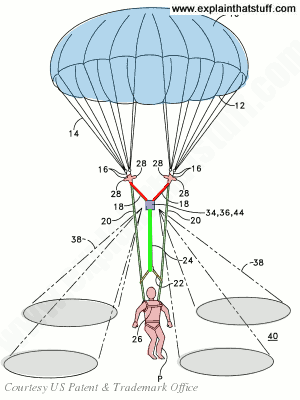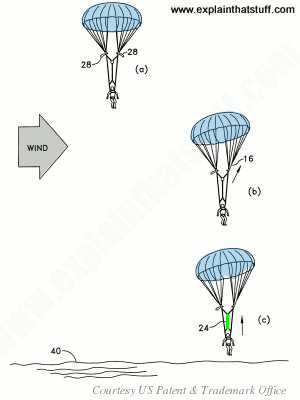
Parachutes
by Chris Woodford. Last updated: February 24, 2023.
You're screaming through the sky, safely tucked up in the cockpit of a jet fighter, when there's a sudden loud bang and the engine judders to a halt. Well that's just great, isn't it? Here you are zooming along at maybe 2000 km/h (1200mph), several kilometers/miles above the ground and your plane has chosen this exact moment to break down! What do you do? Eject as soon as you possibly can, wait for the plane to fly clear, and then hit your parachute. With luck, you glide safely to the ground and live to fly another day. When it comes to saving lives, parachutes are among the simplest and most effective of inventions. How exactly do they work? Let's take a closer look!
Photo: A traditional round parachute. Although military paratroopers still use them, they are now largely obsolete for recreational diving. Photo by Chris Desmond courtesy of US Navy and Wikimedia Commons.
Sponsored links
Contents
How does a parachute work in theory?
Throw a ball up in the air and, sooner or later, it always falls back to the ground. That's because Earth pulls everything toward it with a force called gravity. You've probably learned in school that the strength of Earth's gravity is roughly the same all over the world (it does vary a little bit, but not that much) and that if you drop a heavy stone and a light feather from the top of a skyscraper, gravity pulls them toward the ground at exactly the same rate.

Photo: In theory, different things should fall at the same speed; in practice, it's a bit more complicated.
If there were no air, the feather and the stone would hit the ground at the same time. In practice, the stone reaches the ground much faster, not because it weighs more but because the feather fans out and catches in the air as it falls. Air resistance (also called drag) slows it down.
What causes air resistance?
Just because the air's invisible, doesn't mean it's not there. Earth's atmosphere is packed full of gas molecules, so if you want to move through air—by walking, in a car, in a plane, or dangling from a parachute—you have to push them out of the way. We only really notice this when we're moving at speed.
Air resistance is a bit like the way water pushes against your body when you're in a swimming pool—except that air is invisible! If you jump off a diving board or do a belly flop, the awkward shape of your body will create a a lot of resistance and bring you rapidly to a halt when you crash into the water. But if you make a sharp pointed shape with your arms and dive in gracefully, your body will part the water cleanly and you'll continue to move quickly as you enter it. When you jump or belly flop, your body slows down quickly because the water can't get out of the way fast enough. When you dive, you part the water smoothly in front of you so your body can glide through it quickly. With parachutes, it's the slowing-down effect that we want.
If you fall from a plane without a parachute, your relatively compact body zooms through the air like a stone; open your parachute and you create more air resistance, drifting to the ground more slowly and safely—much more like a feather. Simply speaking, then, a parachute works by increasing your air resistance as you fall.

Photo: Testing a supersonic parachute for NASA's Mars Perseverance rover in a wind tunnel. Photo courtesy of NASA.
Terminal velocity
When a force pulls on something, it makes that object move more quickly, causing it to gain speed. In other words, it causes the object to accelerate. Like any other force, gravity makes falling objects accelerate—but only up to a point.
If you jump out of a plane, your body ought to speed up by 10 meters per second (32ft per second) every single second you're falling. We call that an acceleration of 10 meters per second per second (or 10 meters per second squared, for short, and write it like this: 10m/s/s or 10m/s2). If you were high enough off the ground, then after about a minute and a half (let's say 100 seconds), you'd theoretically be falling at about 1000 meters per second (3600km/h or 2200 mph), which is about as fast as the fastest jet planes have ever flown!

Artwork: When you reach terminal velocity, the upward force of air resistance exactly balances the downward pull of gravity and you stop accelerating.
In practice, that simply doesn't happen. After about 12 seconds, you reach a speed where the force of air resistance (pushing you upward) increases so much that it balances the force of gravity (pulling you downward). At that point, there is no net acceleration and you keep on falling at a steady speed called your terminal velocity. Unfortunately, the terminal velocity for a falling person (with arms stretched out in the classic freefall position) is about 55 meters per second (200km/h or 125 mph), which is still plenty fast enough to kill you—especially if you're falling from a plane!

Photo: 1) Freefall in theory: In this training exercise, the skydiver is practicing freefall by floating over a huge horizontally mounted air fan. The force of the air pushing upward is exactly equal to the diver's weight pulling him downward so he floats in mid-air. Photo by Gary L. Johnson courtesy of US Navy and Wikimedia Commons.

Photo: 2) Freefall in practice: In reality, it's not the air that moves past you—you move through the air—but the physics is still the same: once you reach terminal velocity, the force of the air on your body pushing you upward exactly equals the force of gravity pulling you down. Photo by Ashley Myers courtesy of US Navy and Wikimedia Commons.
How much does a parachute slow you down?
Feathers fall more slowly than stones because their terminal velocity is lower. So another way of understanding how a parachute works is to realize that it dramatically lowers your terminal velocity by increasing your air resistance as you fall. It does that by opening out behind you and creating a large surface area of material with a huge amount of drag. Parachutes are designed to reduce your terminal velocity by about 90 percent so you hit the ground at a relatively low speed of maybe 5–6 meters per second (roughly 20 km/h or 12 mph)—ideally, so you can land on your feet and walk away unharmed.
Sponsored links
What shape are parachutes?

Photo: Square-shaped "ram-air" parachutes are much more common than round parachutes because they're easier to steer and control. Photo by Shannon K. Cassidy courtesy of US Navy and Wikimedia Commons.
Traditionally, parachutes were round (dome-shaped) and, with their dangling suspension lines, looked a bit like jellyfish as they fell. They had vent holes that allowed air to escape, which helped to prevent them from rocking about as they came down, and their lines provided very basic steering.
Most modern parachutes are rectangular (a design known as ram-air). They have a number of cells that inflate as the air "rams" into them, so they form a fairly rigid, curved airfoil wing, which is much more steerable and controllable than a dome-shaped parachute.
Rounder chutes are still widely used by military paratroopers, because they work well for dropping lots of people together, in a fairly small area, at relatively low altitudes; paratroopers are simply trying to get to the ground quickly, not show off their skydiving technique. Recreational divers, on the other hand, consider round chutes obsolete: virtually all of them now use the ram-air design instead.

Photo: Paratroopers often still use round chutes because they're an effective way to get lots of people quickly and safely to the ground in a fairly small space. This parachute drop took place in Latvia in June 2018. Photo by Gina Danals courtesy of US Navy and DVIDS.





